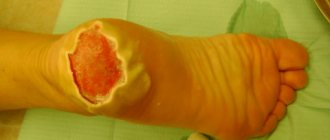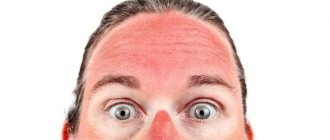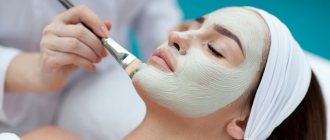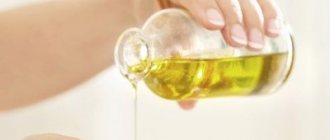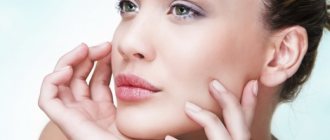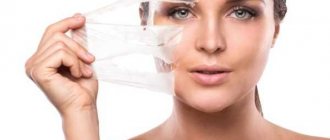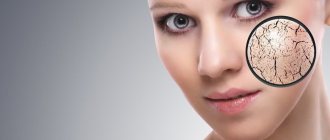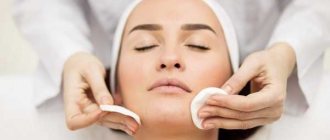From this article you will learn:
- Indications and contraindications for glycolic peeling
- 4 Possible Complications After Glycolic Peel
- 5 stages of glycolic peeling
Glycolic peeling is a superficial chemical procedure that uses a glycolic acid-based solution. This product is perfect for dehydrated and sensitive skin. After several sessions, the face is noticeably renewed and also restores its water balance.
According to experts and clients of beauty salons themselves, such peeling gives the skin freshness on the eve of important events, and does it better than many cosmetic procedures. However, there are also nuances here in the form of contraindications and possible negative consequences.
Normal or complication
Normally, a controlled facial burn appears only after a chemical peel, regardless of the depth of penetration of the active components. This side effect is a protective reaction of the body to the chemical ingredients used in peeling, which activate the regeneration process at the cellular level.
Expert opinion
Elena Apostolyuk
Cosmetologist
If the concentration of the active component is correctly calculated and the protocol for the peeling procedure is followed, a first-degree burn occurs, manifested by itching, mild swelling, hardening of the skin and severe redness. The absence of the described side effects indicates that the peeling was performed incorrectly.
Complications arise due to overexposure of the drug, treatment of areas with open wounds or ulcers, as well as individual intolerance to the components of the chosen product. They appear in the form of burns:
- second degree - pronounced peeling and blisters with liquid form on the face, which burst after a while, which increases the risk of spreading the infection;
- third degree - the skin dies and scabs appear;
- fourth degree - in addition to the epidermis, muscle tissue is damaged.
Deep scars can most often be eliminated only through laser resurfacing or plastic surgery.
Types of chemical peeling and their features
Professional chemical peeling is otherwise called exfoliation. The procedure is carried out using fruit alpha-hydroxy acids, such as grape, lactic, citric, glycolic. After application to the skin, the acid dissolves the top layer of keratinized cells, renewing the epidermis.
Skin exfoliation is chosen based on the depth of penetration of the acid. Depending on this parameter, exfoliation is divided into superficial, middle, and deep. These are the main types of chemical peels that are offered in beauty clinics.
Surface
It has the most gentle effect, comparable to mechanical cleaning, but its effect is softer. It is used to correct minor defects located on the face, décolleté and neck. The drugs used do not penetrate deep and act only on the stratum corneum of the epidermis. The peeling effect depends on the type of acid chosen:
- Milk normalizes hydrobalance, relieves inflammation, softens dry skin. After using lactic acid, hyperpigmentation is eliminated, so it is used for peeling at any time of the year;
- Pyruvic acid is suitable for hypersensitive skin. It increases the density of the epidermis, restores elasticity, and prevents moisture loss;
- Lemon brightens and removes pigmented spots. Chemical peeling with citric acid is suitable for cases where it is necessary to remove acne marks;
- Almond tightens pores, inhibits the growth of pathogenic microorganisms, removes acne well and prevents its appearance.
Superficial skin peeling is also carried out using retinoic acid. However, in terms of penetration depth, this substance is more comparable to the result of mid-cleaning. The composition of retinoic preparations additionally includes vitamin C, kojic and phytic acid. Retinoic cleansing is indicated for biological aging of the dermis, to remove pigmented spots. After the procedure, collagen production increases, which has a positive effect on skin elasticity and allows you to get rid of fine wrinkles.
The effect of chemical peeling, which affects only the surface layer, is clearly noticeable on young skin. That is, periodically such a procedure is recommended for girls under the age of 35 without obvious age-related defects.
Median
In addition to the stratum corneum, acids affect the basal, spinous and granular layers of the epidermis. Medium chemical facial peeling copes well with age-related changes, hyperpigmentation, and wrinkles. It can be used to remove scars and stretch marks. The cleaning process takes place using trichloroacetic acid; if all stages of the procedure are followed, no side effects occur. However, if the manipulation technique is violated, the formation of pigmented spots and scars is possible. Therefore, mid-facial cleansing is trusted only to an experienced cosmetologist.
Median exfoliation is accompanied by moderate painful sensations that disappear within 1-2 hours after completion of the session. Over the course of a week, redness and peeling of the dermis are noted. After a medium chemical peel, care should be as thorough as possible. The skin needs increased hydration throughout the recovery period and must be protected from ultraviolet rays. The optimal period of manipulation is the autumn-winter months of the year.
Deep
It is carried out with those acids that cause destruction of the epidermis down to the mesh layer. Whether to do such a chemical peeling is up to everyone to decide for themselves, but you need to know that the rehabilitation period after the procedure lasts up to 6 months.
Deep chemical peeling is carried out only after high-quality anesthesia. After the manipulation, patients are usually asked to spend 2-3 days under the supervision of medical staff in the clinic. Facial cleansing is based on phenol, which removes almost the entire epidermis down to the papillary layer. This effect is similar to a third degree burn.
Indications for deep chemical peeling are visible scars, deep age wrinkles. Cosmetologists recommend doing such a cleansing only once in a lifetime, so women most often sign up for the procedure after 50-60 years. The manipulation must be performed by a qualified cosmetologist, since the absence of complications depends on the doctor’s experience and strict adherence to all stages.
Causes of burns
During chemical peeling, under the influence of acids, the stratum corneum of the skin is destroyed, and along with it, the active substance also affects the healthy epidermis, which leads to a burn.
A complication in the form of a burn above the first degree after any chemical peel appears due to:
- overexposure of the active substance beyond the recommended time;
- hypersensitive skin;
- allergic reaction to the ingredients of the composition;
- the presence of open wounds on the skin;
- using acid concentrations greater than 30%.
Often the reason for getting a severe burn is the unprofessionalism of the cosmetologist, who incorrectly assesses the initial state of the dermis, and, as a result, makes the peeling with an inappropriate composition.
What peeling products are used?
There are really a lot of acids available for facial cleansing. Such solutions differ in depth of penetration and pharmacological effect.
The best professional chemical peels are;
- Jessner's mixture. Contains resorcinol, lactic and salicylic acid. Gently affects the dermis, evens out the microrelief, smoothes out fine wrinkles;
- TCA. Based on trichloroacetic acid. Used during mid-cleaning, has a cauterizing effect;
- Preparations with phenol. Used for deep exfoliation.
The results of chemical peeling of the skin are comparable to rejuvenation after plastic surgery. But you need to take into account that acid burns the surface layers of the dermis, which, if used incorrectly, can lead to burns and other complications. Therefore, acid peeling should be trusted only to a cosmetologist with a professional education.
Treatment
You can speed up recovery by using drugs based on natural products and medicines, which should be prescribed by a doctor.
Drugs
The following medications are used to treat burns:
- Panthenol. The active substance is dexpanthenol. Increases the density of collagen fibers, has an anti-inflammatory effect and accelerates the regeneration process. Frequency of application – from 2 to 4 times a day. Pantestin or D-panthenol has a similar effect.
- Elokom. A hormonal drug containing mometasone. Available in the form of lotion or ointment, it eliminates itching, swelling and inflammation. Apply to affected areas no more than 1 time per day.
- Bepanten Plus. The base of the cream consists of chlorhexidine and dexpanthenol. Reduces the risk of infectious complications and scars, has a moisturizing, regenerating and antibacterial effect. You can treat the skin 2 times a day.
- Olazol. Anesthetic spray containing sea buckthorn oil and satin. Helps eliminate swelling and severe flaking. Frequency of use: 1–2 times a day.
In case of severe burns, which are accompanied by the appearance of blisters, the specialist prescribes the following therapeutic regimen:
- treating the skin with regenerating preparations to accelerate the healing process - Panthenol or Bepanten;
- the use of glucocorticosteroids to prevent the spread of inflammation - Diprosalik or Elokom;
- the use of antihistamines to eliminate redness, itching and swelling - Zodak or Claritin;
- taking antibiotics in case of infection spreading - Sumamed or Amoxiclav.
Therapy is prescribed by a doctor only after accurately determining the degree of damage to the epidermis.
Folk recipes
Effective natural remedies for the treatment of burns after peeling:
- Vegetable mask. Grate half a peeled cucumber and a medium potato on a fine grater, add a chopped sprig of parsley. Add 1 tsp to the resulting composition. aloe juice, 1 tsp. freshly squeezed lemon juice and 1 tbsp. l. olive oil. Distribute the mixture evenly over the damaged dermis, leave for 15 minutes, rinse with warm water. Repeat treatment once every 5 days for 3–5 weeks. The mask eliminates itching and swelling, and also has a whitening effect.
- Oatmeal decoction. Make a decoction of 100 gr. oatmeal, add 2 tbsp. l. potato starch. Apply to affected areas, leave for 15–20 minutes, rinse. Do the procedure 3 times a week until the epidermis is completely restored. The product will help get rid of burns and red spots in a short time.
- Avocado mask. Mix 1 tsp. liquid honey and 2 tbsp. l. Avocado puree. Heat the resulting mixture in a steam bath and apply to the affected skin, rinse after 20 minutes.
Before using any folk recipe, you should consult a specialist.
Skin care rules
Recommendations for skin care after peeling:
- The burn after glycolic or salicylic peeling is treated several times a day with healing agents based on panthenol. These ointments accelerate the regeneration process and promote skin renewal at the cellular level. Damaged skin should be treated at least 3 times a day.
- The burned epidermis is restored with the help of disinfectants and antiseptics. If there is extensive redness, a specialist may prescribe antihistamines.
- If there is a risk of developing skin diseases, the doctor may prescribe oral antibacterial medications.
- To moisturize your face, you need to regularly apply moisturizing and soothing professional products.
- When going outside, it is imperative to use high-protection sunscreens.
- The skin is protected from sudden temperature changes; it is also necessary to refrain from using scrubbing products, visiting the pool, sauna or solarium.
- The crusts that appear on the face cannot be removed on their own; after washing, the face is wiped with cosmetic wipes - rubbing with a towel will aggravate the existing problems. In case of severe itching, you should treat your face with Elok lotion daily.
- Avoid excessive physical activity, which causes excessive sweating and increases the risk of spreading infection.
- For the entire recovery period, you must avoid using drying cosmetics, as well as foams or wash gels that contain sulfates.
- You should drink at least two liters of water per day - this will help restore water balance and speed up recovery.
- Fatty and salty foods are excluded from the diet.
The average duration of skin restoration is a month. During the entire rehabilitation period, the use of decorative cosmetics, scrubbing and drying agents should be avoided.
Indications and contraindications for glycolic peeling
For what problems is the procedure indicated:
- there are unwanted freckles and age spots;
- there is hyperkeratosis (the skin thickens due to the body getting rid of dead cells too slowly);
- there are signs of photoaging (to slow down or delay the process);
- the skin has become loose and less elastic;
- Acne breakouts occur frequently.
Exfoliation of dead cells with glycolic acid is so gentle that it can be used even in the presence of a number of skin diseases, such as eczema, atopic dermatitis, rosacea. Glycolic peeling has the ability to protect the skin from UV rays, so it is often recommended to do it before vacation to prepare the face for sunbathing. Glycolic peeling will also have obvious benefits after intense tanning - it helps activate the renewal processes of skin damaged by ultraviolet radiation.
Recommended articles on the topic:
- Ultrasonic facial peeling is a pleasant and beneficial procedure for your skin
- Redermalization of the skin: all the pros and cons
- Almond peeling for the face: features of the procedure
All this is due to the properties of glycolic acid, which is considered a natural photoprotector. But it is wrong to think that after such peeling there is no need to use sunscreen - the skin still needs them, so creams with SPF cannot be ignored. Glycolic peeling is an all-season procedure; it can be performed throughout the year.
Contraindications to the procedure are the same as for superficial peeling with alpha hydroxy acids (AHA) - lactic, glycolic, almond, tartaric, malic, kojic, phytic, citric:
- The body does not accept gluconolactone or other peeling components (there were manifestations of an intolerance reaction).
- There are skin diseases in the active phase (acne, hyperkeratosis, etc.).
- A viral infection (herpes, HPV) has worsened.
- The skin has unhealed wounds, abrasions, scratches and other damage.
- There are sunburns or a newly developing tan.
- The body temperature is elevated and there is a fever.
- State of pregnancy or breastfeeding.
Contraindications must be taken seriously and not ignored, otherwise the procedure may result in health problems.
Question answer
What can lead to overexposure of the cleansing composition on the face?
Overexposure of the mixture to the skin leads to burns of varying severity. Then, to restore the skin, you should be examined by a doctor who will prescribe a course of treatment.
For minor damage, it is enough to use a vegetable mask and treat your face with Elok ointment.
How to reduce the risk of burns?
After any chemical peel, a first-degree burn occurs. To quickly get rid of side effects after peeling, it is recommended to smear the skin with Bepanten or Panthenol, try not to go outside during solar activity and remove the crusts yourself.
What results can you expect after peeling?
Exfoliation is a fairly effective cosmetic procedure, useful at any age. Regardless of the type of cleaning, it mainly allows you to achieve the following changes:
- The skin texture is evened out, the color becomes healthier;
- Small wrinkles disappear, and deep ones decrease in size;
- Pigmented spots become almost invisible, not too bright ones disappear completely;
- The hydrobalance of the epidermis is restored;
- Tissue tone increases;
- Local immunity is enhanced;
- The functioning of the sebaceous glands is normalized, which leads to the disappearance of acne and rashes.
The effects described above become clearly visible only after the dermal cells are restored.
The result of chemical peeling depends on its type. Deep allows you to get rid of scars and activate the production of collagen fibers, which gives a pronounced effect of general rejuvenation.
